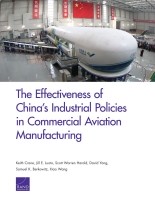| 来源类型 | Research Reports
|
| 规范类型 | 报告
|
| 来源ID | RR-245
|
| The Effectiveness of China's Industrial Policies in Commercial Aviation Manufacturing |
| Keith Crane; Jill E. Luoto; Scott W. Harold; David Yang; Samuel K. Berkowitz; Xiao Wang
|
| 发表日期 | 2014
|
| 出版年 | 2014
|
| 页码 | 112
|
| 语种 | 英语
|
| 结论 |
The Chinese Government Views Aviation Manufacturing as a Priority- Designing and manufacturing passenger jets is seen as an indicator of the nation's technological prowess.
- Aviation manufacturing is also seen as driving economic growth and innovation.
Foreign Companies See Benefits to Investing in China -- Carefully- Foreign companies benefit from interacting with China by providing support to Chinese customers, cultivating a competitive source of parts, and generating sales to Chinese airlines.
- Because of the way the agreements operate, foreign companies are careful to protect intellectual property and technologies.
- Foreign manufacturers say continued innovation is key to preventing emergence of Chinese competitors.
China's Commercial Aviation Manufacturing Industry Is Still Developing- The planes currently in development are not likely to be competitive when finally realized. The Chinese government will then have to invest heavily in developing a new round of planes that might be more competitive.
- It is possible China will be more successful in general aviation, building smaller aircraft for private or charter use.
Foreign Competitors Struggle with Negotiating Agreements with China- If China succeeds in penetrating the commercial aviation manufacturing market, other countries may want to consider several policy options.
- China also should consider the opportunity costs of its policies and whether to pursue more market-oriented policies.
|
| 摘要 |
- The U.S. government could engage in bilateral negotiations with the EU to pressure Airbus and Boeing to reduce the use of purchases of components as a marketing tool.
- The United States and EU could push for more transparent tenders for purchases of aircraft by Chinese state-owned airlines.
- They could also monitor development of Chinese technology and intervene through the World Trade Organization and bilateral forums in response to efforts to use subsidies or other supports to enter U.S. or EU markets. They could also continue to press the Chinese government in these arenas to dispense with industry-specific industrial policies.
- If China wishes to become fully integrated into the global commercial aviation manufacturing industry, China's government would be well advised to change its current policies to create a more equitable business environment for both foreign and Chinese commercial aviation manufacturers.
|
| 主题 | Aircraft
; China
; International Trade
; Transportation Economics
|
| URL | https://www.rand.org/pubs/research_reports/RR245.html
|
| 来源智库 | RAND Corporation (United States)
|
| 资源类型 | 智库出版物
|
| 条目标识符 | http://119.78.100.153/handle/2XGU8XDN/107705
|
推荐引用方式
GB/T 7714 |
Keith Crane,Jill E. Luoto,Scott W. Harold,et al. The Effectiveness of China's Industrial Policies in Commercial Aviation Manufacturing. 2014.
|
|
文件名:
|
x1495315148436.jpg
|
|
格式:
|
JPEG
|

|
文件名:
|
RAND_RR245.pdf
|
|
格式:
|
Adobe PDF
|
除非特别说明,本系统中所有内容都受版权保护,并保留所有权利。